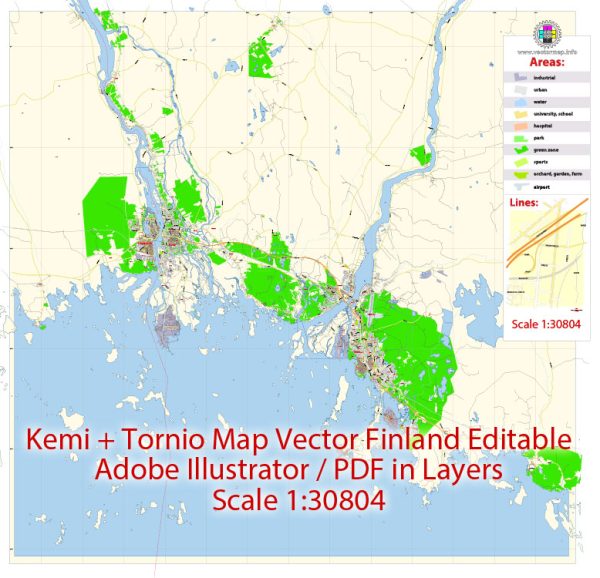Kemi and Tornio are two neighboring cities located in the Lapland region of northern Finland. They are situated near the Gulf of Bothnia, which is an arm of the Baltic Sea. Here is a detailed description of the area:
- Geography:
- Location: Kemi and Tornio are situated in the northern part of Finland, close to the border with Sweden. The Gulf of Bothnia lies to the west of the cities.
- Climate: The region experiences a subarctic climate with cold winters and relatively mild summers. Snowfall is common in the winter months.
- Kemi:
- Cityscape: Kemi is known for its unique architecture, including the SnowCastle (LumiLinna), which is rebuilt each winter using snow and ice. The city is also home to the Kemi Gemstone Gallery, showcasing a variety of gemstones.
- Economy: Historically, Kemi has been an important center for the paper and pulp industry, with major mills contributing to the local economy.
- Tornio:
- Border City: Tornio is located on the border with Sweden, and it shares the twin city designation with Haparanda, its Swedish counterpart. The two cities form a cross-border conurbation.
- Historical Significance: Tornio has a rich history, and the Old Church of Tornio, dating back to the 17th century, is one of the city’s notable historical landmarks.
- Joint Features:
- Industry: Both Kemi and Tornio are known for their industrial activities, including steel production. The Outokumpu stainless steel plant, located in Tornio, is one of the largest in Europe.
- Transportation: The cities are well-connected by road and rail. The Kemi-Tornio Airport serves the region with domestic flights.
- Nature and Recreation:
- Nature Reserves: The surrounding region features natural attractions such as the Bothnian Bay National Park, providing opportunities for outdoor activities like hiking and bird watching.
- Winter Tourism: The area attracts visitors during the winter season for activities like snowmobiling, ice fishing, and enjoying the Northern Lights.
- Cultural Attractions:
- Museums: Both cities have museums that showcase the local history and culture. For example, the Provincial Museum of Tornio focuses on the region’s cultural heritage.
- Language and Culture:
- Bilingualism: Due to the proximity to Sweden, there is a significant bilingual population, and both Finnish and Swedish are commonly spoken.
In summary, Kemi and Tornio, located in the northern reaches of Finland, offer a mix of industrial heritage, cultural attractions, and opportunities for outdoor activities, making them interesting destinations for both locals and visitors alike.
Vectormap.Net provide you with the most accurate and up-to-date vector maps in Adobe Illustrator, PDF and other formats, designed for editing and printing. Please read the vector map descriptions carefully.


 Author: Kirill Shrayber, Ph.D.
Author: Kirill Shrayber, Ph.D.